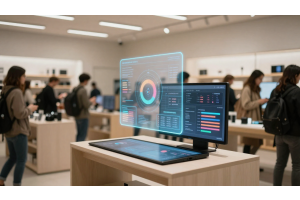Modern Payment Systems: Stop Losing Customers at Checkout

Modern Payment Systems: Stop Losing Customers at Checkout
Outdated payment systems cost retailers billions in lost sales. 70.19% of shopping carts get abandoned before purchase, with payment friction being a major cause. Modern checkout technology can cut abandonment rates dramatically and boost conversion rates by up to 88%.
Smart payment systems solve critical checkout problems that drive customers away. Mobile checkout has an 85.65% abandonment rate, while the average merchant reported 3% of orders in the past 12 months were fraudulent, creating trust issues that compound abandonment problems.
The financial impact is massive. Digital wallet transactions reached $10 trillion globally in 2024 and will grow 70% to exceed $17 trillion by 2029. Voice commerce spending will reach nearly $82 billion by 2025, while global voice commerce market will reach $421.7 billion by 2029.
Table Of Content
Critical Payment System Problems Driving Customer Loss
Most checkout failures stem from preventable technical and design issues. Understanding these problems helps you prioritize which payment upgrades deliver the biggest impact.
Insufficient Payment Method Options
48% of shoppers abandon carts when they see unexpected fees, while limited payment choices frustrate customers who expect flexibility. Loyalty points fraud attacks reached 6.19% in Q1 2025, making secure payment diversity even more critical.
Modern customers demand payment options that match their preferences and security expectations:
| Payment Type | Adoption Rate | Security Level | Customer Preference |
|---|---|---|---|
| Digital Wallets | 54% of eCommerce by 2026 | High encryption | Quick checkout preference |
| BNPL Services | 45% growth in 2024 | Moderate risk | Large purchase preference |
| Open Banking | 30% cost reduction | Bank-level security | Direct transfer preference |
| Cryptocurrency | 15% acceptance rate | Blockchain security | Tech-savvy preference |
| Voice Payments | 154.3 million users in 2025 | Biometric verification | Hands-free preference |
Legacy Technology Barriers
Customers expect frictionless payments without manual data entry. Machine learning for improved authorization is the top payment trend for 2025, yet many businesses still rely on outdated systems.
Legacy systems cause immediate abandonment through:
- Manual credit card number entry requirements
- Multiple form fields for billing information
- Forced account creation before purchase
- Password authentication for stored cards
- Lack of biometric payment options
- Missing voice payment integration
Advanced Security Vulnerabilities
Predictions for 2025 include a rise in digital e-skimming and scam e-commerce, making robust security essential for customer trust. Payment fraud costs businesses an average of $3 for every $1 lost to fraud.
Critical Security Gaps:
| Vulnerability Type | Business Impact | Prevention Strategy | Implementation Priority |
|---|---|---|---|
| Card Skimming | 15% revenue loss | Tokenization systems | High |
| Identity Theft | 25% customer churn | Biometric verification | High |
| Account Takeover | 40% support ticket increase | Multi-factor authentication | Medium |
| Synthetic Fraud | 8% false decline rate | AI behavior analysis | Medium |
| Social Engineering | 20% brand damage | Customer education | Low |
Missing Personalization Features
Personalized checkout experiences boost sales by 20%. AI-enabled sites see 47% faster purchases, yet most payment systems lack intelligent customization.
Without personalization, customers face:
- Generic checkout flows that ignore purchase history
- Irrelevant payment method suggestions based on demographics
- Disconnected loyalty program experiences
- Inconsistent payment options across channels
- No predictive payment recommendations
Limited Global Payment Support
International customers need localized payment options and multi-currency support. Cross-border payment restrictions lose global sales opportunities worth billions annually.
Payment system gaps include:
- Currency conversion limitations
- Missing regional payment methods (WeChat Pay, Alipay, PIX)
- Complex international transaction fees
- Regulatory compliance failures (PSD2, GDPR)
- Language barriers in payment interfaces
Tip
To enhance your eCommerce store’s performance with Magento, focus on optimizing site speed by utilizing Emmo themes and extensions. These tools are designed for efficiency, ensuring your website loads quickly and provides a smooth user experience. Start leveraging Emmo's powerful solutions today to boost customer satisfaction and drive sales!
Revolutionary Payment Technologies Transforming Checkout
Breakthrough technologies are eliminating traditional checkout barriers and creating seamless purchase experiences.
Voice Commerce Integration
More than 60% of smartphone users use voice search in their day-to-day life while shopping. Voice purchases grew from $4.6 billion in 2021 to nearly $20 billion in 2023—nearly 400% growth in two years.
Voice payment capabilities transform checkout through:
- Hands-free purchasing: Complete transactions without touching devices
- Natural language processing: Understand complex purchase requests
- Contextual recommendations: Suggest products based on voice queries
- Biometric authentication: Voice recognition for secure payments
- Multi-device continuity: Start on phone, complete on smart speaker
Voice Commerce Implementation Roadmap:
| Phase | Timeline | Key Features | Expected ROI |
|---|---|---|---|
| Voice Search | Month 1-2 | Product discovery via voice | 25% search engagement increase |
| Voice Ordering | Month 3-4 | Simple reorder commands | 40% repeat purchase improvement |
| Voice Payments | Month 5-6 | Secure transaction completion | 60% checkout time reduction |
| AI Integration | Month 7-8 | Predictive voice recommendations | 80% personalization accuracy |
Conversational Commerce Systems
Retail chatbot spending hit $142 billion in 2024, with conversational commerce market expected to reach $17.55 billion by 2029. Chat-based payments eliminate traditional checkout friction entirely.
Conversational Payment Benefits:
| Feature | Customer Impact | Business Benefit | Technical Requirement |
|---|---|---|---|
| Real-time Support | 85% satisfaction improvement | 35% conversion increase | NLP integration |
| Payment Within Chat | 70% faster completion | 50% abandonment reduction | Secure API channels |
| Product Discovery | 90% engagement boost | 45% average order increase | ML recommendation engine |
| Order Tracking | 95% transparency rating | 60% support ticket reduction | System integration |
Digital Wallets and Super Apps
Digital wallets manage over 20% of global consumer spending in 2024, with 15% annual growth projected through 2027. Super apps combine payments, loyalty, and financial services in unified platforms.
Advanced Digital Wallet Features:
| Capability | Market Adoption | Customer Preference | Revenue Impact |
|---|---|---|---|
| One-click payments | 88.7% conversion rate | 95% prefer stored methods | 40% revenue increase |
| Loyalty integration | 67% wallet users | 85% expect rewards | 25% repeat purchase boost |
| Cryptocurrency support | 23% wallet adoption | 45% crypto user preference | 15% new customer acquisition |
| International transfers | 34% cross-border usage | 78% prefer wallet transfers | 30% global sales increase |
Open Banking Revolution
Open Banking enables direct bank-to-bank payments at 60% lower processing costs than traditional card payments. Real-time payment systems will become increasingly popular as financial institutions ramp up adoption.
Open Banking Advantages:
| Benefit Category | Impact Measurement | Implementation Cost | Payback Period |
|---|---|---|---|
| Lower Transaction Fees | 60% cost reduction vs cards | $50K initial investment | 6 months |
| Real-time Confirmation | 95% instant payment success | $25K integration cost | 4 months |
| Enhanced Security | 80% fraud reduction | $75K security setup | 8 months |
| Rich Data Analytics | 200% customer insight improvement | $30K analytics platform | 5 months |
AI-Powered Fraud Prevention
Machine learning for improved authorization is the top payment trend, with AI systems detecting fraud patterns human analysts miss.
AI Fraud Detection Capabilities:
| AI Technology | Detection Accuracy | False Positive Rate | Implementation Complexity |
|---|---|---|---|
| Behavioral Biometrics | 99.5% fraud detection | 0.1% false positives | High |
| Transaction Pattern Analysis | 96% accuracy | 2% false positives | Medium |
| Device Fingerprinting | 94% accuracy | 3% false positives | Low |
| Real-time Risk Scoring | 97% accuracy | 1.5% false positives | Medium |
Advanced Payment Optimization Framework
Track personalization impact across the entire customer lifecycle, not just immediate conversions.
Comprehensive Metrics Framework
| Metric Category | Key Indicators | Measurement Method | Target Improvement | Immediate Impact |
|---|---|---|---|---|
| Conversion rate, CTR | Real-time analytics | 25-45% increase | ||
| Customer Value | AOV, purchase frequency | Monthly cohort analysis | 30-60% improvement | |
| Retention Metrics | Churn rate, repeat purchases | Quarterly customer surveys | 40-70% better retention | |
| Predictive Accuracy | Recommendation relevance | Customer feedback scores | 80%+ relevance ratings | |
| Operational Efficiency | Support ticket reduction | Help desk analytics | 35% fewer inquiries |
Advanced Analytics Implementation
Calculate personalization ROI using customer lifetime value improvements, not just immediate sales increases. AI personalization typically pays for itself within 6-8 months through reduced marketing costs and improved customer retention.
ROI Calculation Framework:
- Implementation costs: Software licenses, integration work, staff training
- Revenue improvements: Higher conversion rates, increased order values
- Cost reductions: Lower marketing spend, reduced support needs
- Efficiency gains: Automated personalization replacing manual processes
Track competitive advantages that AI personalization creates. Customers who experience high-quality personalization become less price-sensitive and more resistant to competitor offers.
Future-Proofing Your Personalization Strategy
Companies that lead in this space don't chase trends, they operationalize them. Build systems that adapt to emerging AI capabilities without requiring complete rebuilds.
2025 Emerging Trends:
- Emotional AI: Systems that recognize customer mood and adapt recommendations accordingly
- Predictive Commerce: AI that orders products before customers request them
- Conversational Personalization: Voice and chat interfaces with individualized personalities
- Contextual Intelligence: Recommendations based on weather, events, and social trends
Design your AI architecture to integrate new capabilities seamlessly. Modular systems allow rapid adoption of breakthrough personalization technologies without disrupting existing operations.
Privacy and Ethics Framework:Build transparent personalization that respects customer boundaries. AI trends indicate adherence to ethics is expected to see significant progress with a focus on transparency, fairness, and accountability.
Implement customer control mechanisms that let users adjust personalization intensity, see recommendation reasoning, and opt out of specific data usage while maintaining overall system benefits.
Success Measurement Beyond Metrics:Monitor customer sentiment through surveys and social listening. The best AI personalization feels helpful rather than intrusive, creating positive emotional associations with your brand that drive long-term loyalty beyond immediate sales increases.
Strategic Implementation Roadmap
Banks have succeeded in reducing costs from 3 to 5 percent at most banks to as much as 10 percent for the most successful ones, but sustainable transformation requires strategic planning beyond cost reduction.
Ethical AI and Privacy in Banking Automation
Phase 1: Foundation Building (Months 1-6)
Organizations start with a data quality assessment and system integration to ensure AI reliability. Pilot programs run in low-risk areas like document processing and customer service, with success metrics establishing a baseline for wider adoption.
Phase 2: Core Process Automation (Months 6-18)
Automation expands into mission-critical areas such as lending, compliance, and customer onboarding. Machine learning models train on historical data, supported by human oversight to ensure accuracy. Governance frameworks address ethics, risk, and performance, while change management programs prepare employees for evolving roles.
Phase 3: Intelligent Optimization (Months 18-36)
AI-driven optimization enhances workflows, resource allocation, and customer experiences. Predictive analytics reduce manual analysis, while personalization engines deliver tailored services at scale. External data integration further strengthens decision-making and competitive positioning.
Success Factors for Banking Automation
High-quality data and strong security frameworks safeguard compliance and customer trust. Employee training ensures adoption and productivity, while strategic partnerships provide specialized expertise. Continuous monitoring and optimization keep systems aligned with business goals and regulatory requirements.
ROI Analysis: Balancing Ethics with Innovation Profits
Predictive Payment Analytics
Use machine learning to predict payment method preferences, optimal pricing strategies, and fraud risks before transactions occur.
Predictive Analytics Applications:
| Prediction Type | Data Sources | Accuracy Rate | Business Impact |
|---|---|---|---|
| Payment Method Preference | Purchase history, demographics | 87% accuracy | 30% conversion improvement |
| Fraud Risk Assessment | Behavioral patterns, device data | 94% accuracy | 75% fraud reduction |
| Optimal Pricing Timing | Market data, user behavior | 82% accuracy | 20% revenue increase |
| Churn Risk Identification | Payment failures, engagement | 89% accuracy | 45% retention improvement |
Dynamic Payment Routing
Automatically route payments through optimal processors based on success rates, costs, and customer preferences.
Smart Routing Benefits:
| Strategy | Benefits |
|---|---|
| Routing Strategy |
Success Rate Improvement Cost Reduction Customer Experience Geographic Optimization |
| Success Rate Improvement | 15% better authorization |
| Cost Reduction | 25% processing savings |
| Customer Experience | Faster local processing |
| Currency Matching |
20% international success 30% FX cost reduction Native currency display |
| Risk-Based Routing |
35% fraud prevention 40% chargeback reduction Seamless high-risk handling |
| Load Balancing |
10% uptime improvement 20% infrastructure savings Consistent performance |
Real-Time Payment Personalization
Customize payment experiences instantly based on customer behavior, purchase patterns, and contextual data.
Personalization Engine Components:
| Component | Details |
|---|---|
| Payment Method Ranking | Sub-second response, Individual preferences, Machine learning models |
| Dynamic Offer Display | Instant price optimization, Behavioral targeting, Real-time analytics |
| Fraud Risk Adjustment | Immediate risk scoring, Historical pattern analysis, AI processing power |
| Currency Selection | Location-based auto-selection, Multi-region support, Geographic APIs |
Comprehensive ROI Measurement Framework
Advanced Performance Metrics
Track sophisticated payment KPIs that reveal hidden optimization opportunities and predict future performance trends.
Next-Generation Payment Metrics::
| Metric Category | Key Indicators | Measurement Frequency | Target Benchmarks | Predictive Success |
|---|---|---|---|---|
| Authorization rate forecasting | Real-time | 90%+ accuracy | ||
| Customer Lifetime Value | Payment-driven CLV growth | Monthly | 25% CLV increase | |
| Operational Efficiency | Automated processing rate | Daily | 80% automation | |
| Security Performance | AI-detected threat prevention | Continuous | 99%+ threat detection | |
| Cross-channel Consistency | Omnichannel payment parity | Weekly | 95% experience consistency |
Advanced Business Impact Analysis
Revenue Attribution Framework:
| Metric | Details |
|---|---|
| Revenue Source | Attribution Method |
| Growth Measurement | Optimization Priority |
| Payment Method Expansion | A/B test comparison |
| Month-over-month growth | High |
| Fraud Prevention Savings | Cost avoidance calculation |
| Quarterly assessment | High |
| Conversion Rate Optimization | Cohort analysis |
| Weekly trending | Medium |
| Customer Retention Value | Lifetime value modeling |
| Annual evaluation | Medium |
Future-Proof Implementation Strategy
2025-2030 Payment Evolution Roadmap
Prepare for payment technologies that will dominate the next decade.
Emerging Payment Technologies:
| Technology | Maturity Timeline | Market Impact Potential | Investment Priority |
|---|---|---|---|
| Quantum-Resistant Security | 2026-2027 | Revolutionary | Prepare now |
| Neural Payment Interfaces | 2027-2028 | Transformative | Monitor closely |
| Autonomous Payment Systems | 2025-2026 | Significant | Start piloting |
| Holographic Authentication | 2028-2029 | Moderate | Research phase |
Strategic Implementation Plan
Year 1 (Foundation):
- Deploy core digital wallet integration across all channels
- Implement AI-powered fraud detection with 99%+ accuracy
- Launch voice commerce capabilities for key product categories
- Establish real-time payment analytics infrastructure
Year 2 (Expansion):
- Integrate conversational commerce with natural language processing
- Deploy predictive payment routing for global optimization
- Launch biometric authentication across mobile platforms
- Implement quantum-resistant encryption preparation
Year 3 (Innovation):
- Deploy fully autonomous payment recommendations
- Launch cross-platform voice payment continuity
- Implement predictive customer service for payment issues
- Prepare for neural interface payment integration
Conclusion
Modern payment systems represent the difference between thriving and surviving in the digital economy. Companies that implement advanced payment technologies now will capture disproportionate market share as customer expectations continue evolving toward frictionless, intelligent, and secure payment experiences.
FAQs
What are modern payment systems?
Modern payment systems are advanced digital solutions that support fast, secure, and flexible transactions across multiple channels, reducing friction at checkout.
Why do customers abandon carts at checkout?
Common reasons include limited payment options, lengthy checkout processes, hidden fees, or lack of trust in security. Modern payment systems address these issues directly.
How do modern payment systems reduce checkout friction?
They provide one-click payments, support multiple methods like digital wallets, enable faster authentication, and simplify the overall user experience.
What payment methods should businesses support?
Popular methods include credit/debit cards, PayPal, Apple Pay, Google Pay, BNPL (Buy Now, Pay Later), and even cryptocurrency for global customers.
Are modern payment systems secure?
Yes. They use advanced encryption, tokenization, fraud detection, and compliance standards like PCI DSS to keep transactions safe.
How can payment speed affect sales?
Slow checkouts frustrate customers, leading to higher abandonment rates. Faster payment systems reduce drop-offs and increase completed sales.
Do mobile payment options really matter?
Absolutely. With most shoppers buying through mobile devices, offering seamless mobile wallets and responsive checkout is critical for retaining customers.
How do modern payment systems improve global sales?
They support multiple currencies, cross-border compliance, and localized payment preferences, helping businesses expand internationally without losing customers.
Are modern payment systems cost-effective for businesses?
Yes. Although setup costs may vary, businesses save money through reduced cart abandonment, higher conversion rates, and better fraud protection.
What is the future of payment systems?
The future includes AI-driven fraud detection, biometric authentication, seamless subscription billing, and real-time global payment routing to maximize efficiency.









